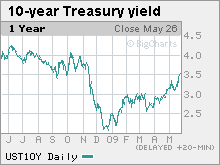Bonds turn lower
Government debt prices dip midway through a week with heavy supply and Fed purchase operations. Investor risk appetite starts to return.
NEW YORK (CNNMoney.com) -- Government debt prices fell Wednesday, midway through a week chock full of carefully watched debt auctions and government purchase operations.
The government has initiated scores of stimulus programs to spur the economy which have left a massive deficit that the U.S. has been funding through debt auctions.
On Tuesday, Treasury sold $40 billion in 2-year notes, which garnered $117.5 billion in bids. The Treasury auctioned $35 billion in 5-year notes Wednesday, drawing a more modest $81.3 billion in bids and a bid-to-cover ratio of 2.32.
The market was bracing for the third major auction of the week, $26 billion in 7-year notes on Thursday, bringing this week's total to $101 billion.
The Treasury market is looking to these auctions for clues on how demand is holding up. Traditionally, foreign countries have served as major players in the Treasury market. But they have become nervous about U.S. creditworthiness as the government prints more money.
Last week, Standard & Poor's lowered its outlook for the United Kingdom to "negative" from "stable," citing concerns that Britain's debt burden could reach 100% of its gross domestic product. Investors feared a similar fate could occur in the United States.
However, Moody's Investor Services, another major ratings agency, on Wednesday confirmed the United States' AAA credit rating. "Moody's base case is that the economic strength of the U.S. will emerge after the crisis without major impairment," the report said, even despite the government's balance sheet.
The government is selling debt at a breakneck pace while it is also steadily buying back $300 billion of its own debt as part of a program called "quantitative easing."
The idea is that as the government creates demand for its own debt, prices are supported and yields fall. Tuesday, the Fed bought $1.6 billion in TIPS, or Treasury Inflation Protected Securities. Wednesday, the government bought $6 billion in debt that matures between May 2012 and August 2013.
Economic upswing. Also testing the U.S. debt market, investors have shifted into other higher yielding markets, including equities, corporate bonds and commodities.
Softening demand for U.S. debt is a sharp reversal from the end of 2008, when the economy crumbled and demand for the ultra-safe asset skyrocketed.
Late in Wednesday's session, the spread between the benchmark yield curve widened to 274 basis points, which was the widest it has been since 2003, approaching a record spread.
The benchmark yield curve measures the difference between the yield on the 10-year note and the 2-year note. When the spread between the two yields widens, that tends to signal that a recovery is on the horizon.
Bond prices. The benchmark 10-year note fell 1 7/32 to 95 8/32, and its yield rose to 3.71% from 3.55% late Tuesday. Bond prices and yields move in opposite directions.
The 30-year bond fell 1 22/32 to 94 11/32, and its yield rose to 4.6% from 4.49%.
The 2-year note edged down 3/32 at 99 27/32 and its yield ticked higher to 0.97% from 0.91%. The yield on the 3-month note dipped to 0.17%.
Lending rates. One key bank-to-bank lending rate edged slightly off a record low. The 3-month Libor was 0.67% Wednesday, up slightly from 0.66% the day before, according to Bloomberg.com.
Meanwhile, the overnight Libor rate ticked up to 0.26% from 0.23%.
Libor, the London Interbank Offered Rate, is a daily average of rates that 16 different banks charge each other to lend money in London. The closely watched benchmark is used to calculate adjustable-rate mortgages. More than $350 trillion in assets are tied to Libor. ![]()


